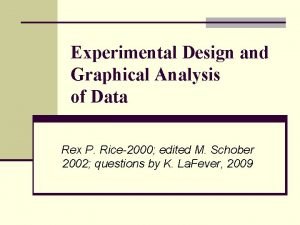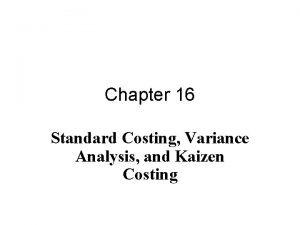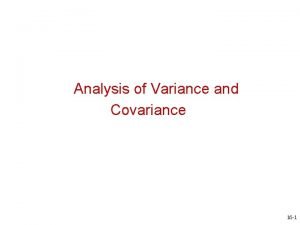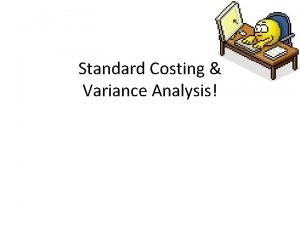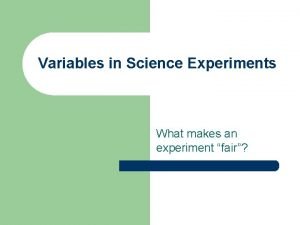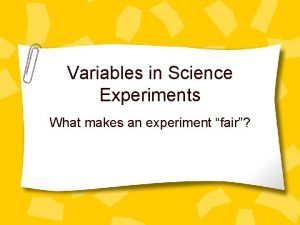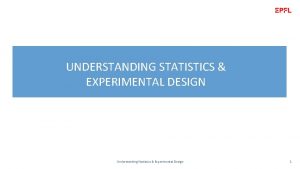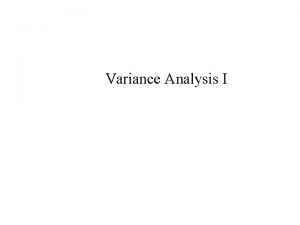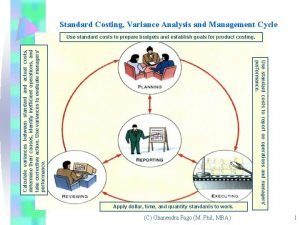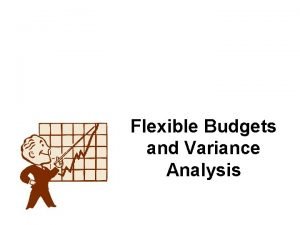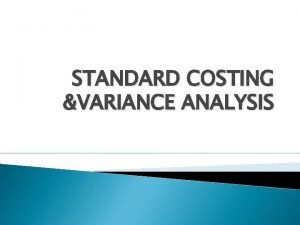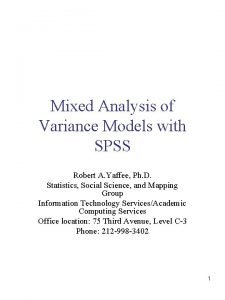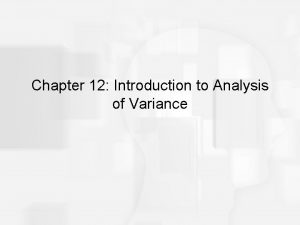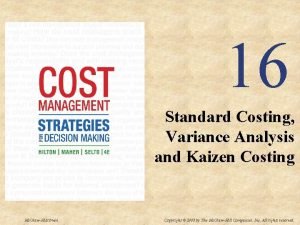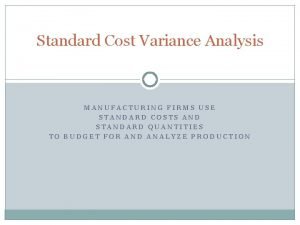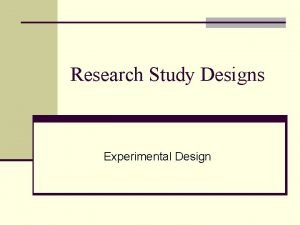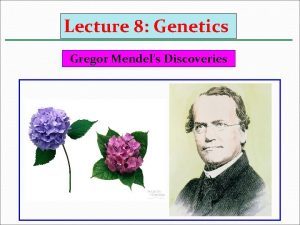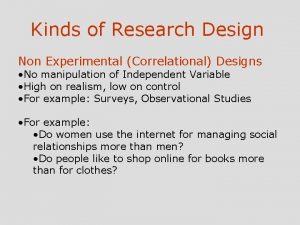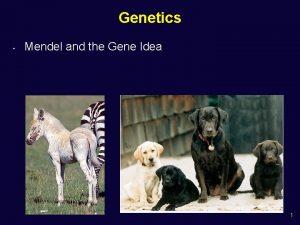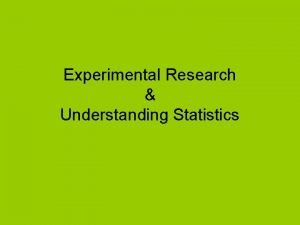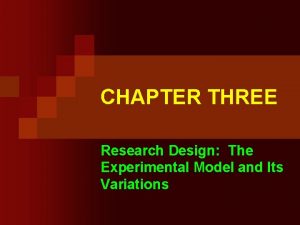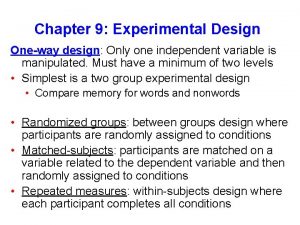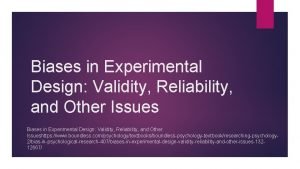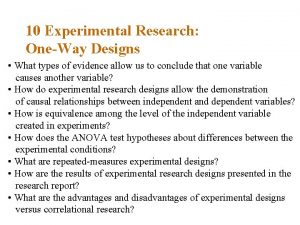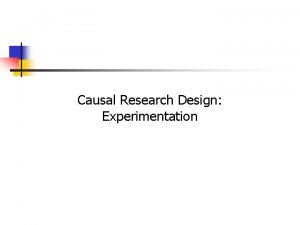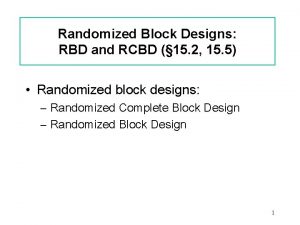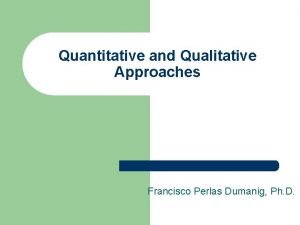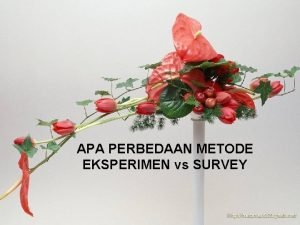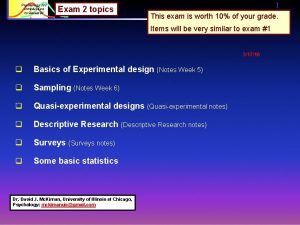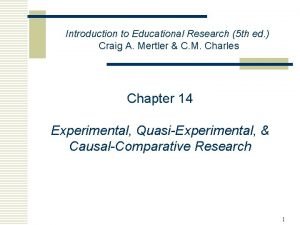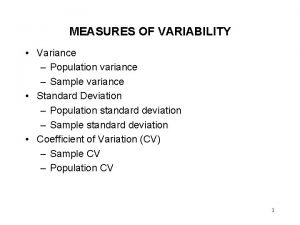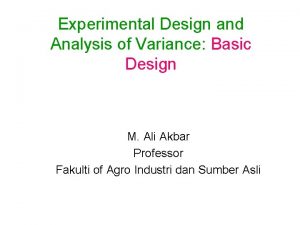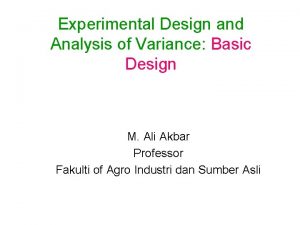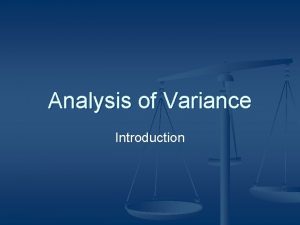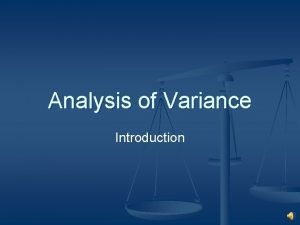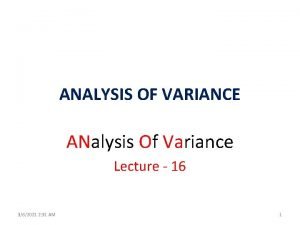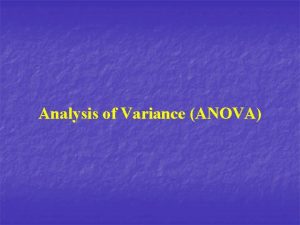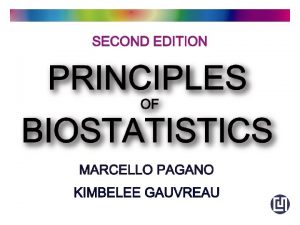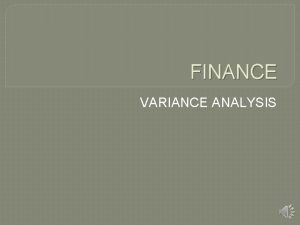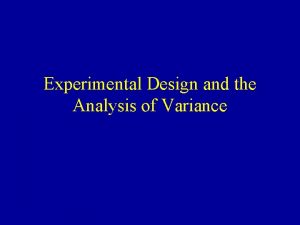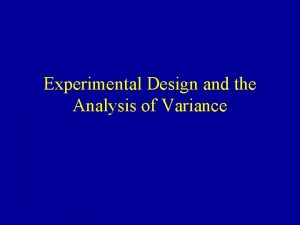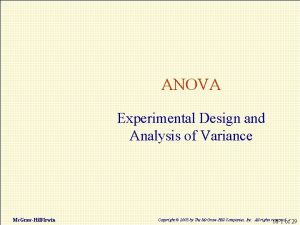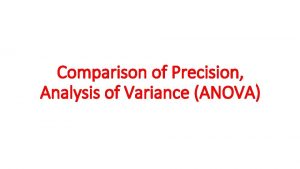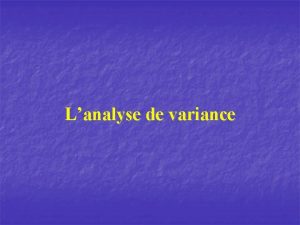Chapter 11 Experimental Design and Analysis of Variance







































































- Slides: 71

Chapter 11 Experimental Design and Analysis of Variance Mc. Graw-Hill/Irwin Copyright © 2009 by The Mc. Graw-Hill Companies, Inc. All Rights Reserved.

Experimental Design and Analysis of Variance 11. 1 Basic Concepts of Experimental Design 11. 2 One-Way Analysis of Variance 11. 3 The Randomized Block Design 11. 4 Two-Way Analysis of Variance 11 -2

Basic Concepts of Experimental Design • Up until now, we have considered only two ways of collecting and comparing data: – Using independent random samples – Using paired (or matched) samples • Often data is collected as the result of an experiment – To systematically study how one or more factors (variables) influence the variable that is being studied 11 -3

Experimental Design #2 • In an experiment, there is strict control over the factors contributing to the experiment – The values or levels of the factors are called treatments • For example, in testing a medical drug, the experimenters decide which participants in the test get the drug and which ones get the placebo, instead of leaving the choice to the subjects • The object is to compare and estimate the effects of different treatments on the response variable 11 -4

Experimental Design #3 • The different treatments are assigned to objects (the test subjects) called experimental units – When a treatment is applied to more than one experimental unit, the treatment is being “replicated” • A designed experiment is an experiment where the analyst controls which treatments are used and how they are applied to the experimental units 11 -5

Experimental Design #4 • In a completely randomized experimental design, independent random samples are assigned to each of the treatments – For example, suppose three experimental units are to be assigned to five treatments – For completely randomized experimental design, randomly pick three experimental units for one treatment, randomly pick three different experimental units from those remaining for the next treatment, and so on 11 -6

Experimental Design #5 • Once the experimental units are assigned and the experiment is performed, a value of the response variable is observed for each experimental unit – Obtain a sample of values for the response variable for each treatment 11 -7

Experimental Design #6 • In a completely randomized experimental design, it is presumed that each sample is a random sample from the population of all possible values of the response variable – That could possibly be observed when using the specific treatment – The samples are independent of each other • Reasonable because the completely randomized design ensures that each sample results from different measurements being taken on different experimental units • Can also say that an independent samples experiment is being performed 11 -8

Example 11. 1: Gasoline Mileage Case • Compare the effects of three types of gasoline (Types A, B, and C) on the gasoline mileage of a particular make and model midsized automobile – The response variable is gasoline mileage, in miles per gallon (mpg) – The gasoline types (A, B, or C) are the treatments 11 -9

Example 11. 1: Gasoline Mileage Case #2 • Use a completely randomized experimental design – Have available 1, 000 cars for testing – Need samples of size five for each gasoline type – Randomly select five cars from the 1, 000 cars; assign these five to get gasoline type A – Randomly select five cars from the 995 remaining cars; these five are assigned to get gasoline type B – Randomly select five cars from the 990 remaining cars; these five are assigned to get gasoline type C • Each randomly selected car is test driven using the appropriate gasoline type and driving conditions 11 -10

Example 11. 1: Gasoline Mileage Case #3 • The mileage data is listed on the next slide (Table 11. 1) – Let xij denote the mileage x of the jth car (j = 1, 2, … , 5) using gasoline type i (i = A, B, or C) – Assume that the mileage data for a particular gasoline type is a random sample of all possible mileages using that type 11 -11

Example 11. 1: Gasoline Mileage Case #4 Type A Type B Type C x. A 1=34. 0 x. A 2=35. 0 x. A 3=34. 3 x. A 4=35. 5 x. A 5=35. 8 x. B 1=35. 3 x. B 2=36. 5 x. B 3=36. 4 x. B 4=37. 0 x. B 5=37. 6 x. C 1=33. 3 x. C 2=34. 0 x. C 3=34. 7 x. C 4=33. 0 x. C 5=34. 9 11 -12

Example 11. 1: Gasoline Mileage Case #5 Looking at the box plots below, we could get the idea that type B gives the highest gasoline mileage 11 -13

One-Way Analysis of Variance • Want to study the effects of all p treatments on a response variable – For each treatment, find the mean and standard deviation of all possible values of the response variable when using that treatment – For treatment i, find treatment mean µi • One-way analysis of variance estimates and compares the effects of the different treatments on the response variable – By estimating and comparing the treatment means µ 1, µ 2, …, µp – One-way analysis of variance, or one-way ANOVA 11 -14

Example 11. 4: Gasoline Mileage Case • The mean of a sample is the point estimate for the corresponding treatment mean x. A = 34. 92 mpg estimates m. A x. B = 36. 56 mpg estimates m. B x. C = 33. 98 mpg estimates m. C 11 -15

Example 11. 4: Gasoline Mileage Case Continued • The standard deviation of a sample is the point estimate for the corresponding treatment standard estimates s. A = 0. 7662 mpg estimates σA s. B = 0. 8503 mpg estimates σB s. C = 0. 8349 mpg estimates σC 11 -16

ANOVA Notation • ni denotes the size of the sample randomly selected for treatment i • xij is the jth value of the response variable using treatment i • xi is average of the sample of ni values for treatment i – xi is the point estimate of the treatment mean µi • si is the standard deviation of the sample of ni values for treatment i – si is the point estimate for the treatment (population) standard deviation σi 11 -17

One-Way ANOVA Assumptions • Completely randomized experimental design – Assume that a sample has been selected randomly for each of the p treatments on the response variable using a completely randomized experimental design • Constant variance – The p populations of values of the response variable (associated with the p treatments) all have the same variance 11 -18

One-Way ANOVA Assumptions Continued • Normality – The p populations of values of the response variable all have normal distributions • Independence – The samples of experimental units are randomly selected, independent samples 11 -19

Notes on Assumptions • One-way ANOVA is not very sensitive to violations of the equal variances assumption – Especially when all the samples are about the same size – All of the sample standard deviations should be reasonably equal to each other 11 -20

Notes on Assumptions Continued • Normality is not crucial – ANOVA results are approximately valid for mound-shaped distributions • If the sample distributions are reasonably symmetric and if there are no outliers, then ANOVA results are valid for even small samples • For gasoline mileages, the assumptions are roughly satisfied 11 -21

Testing for Significant Differences Between Treatment Means • Are there any statistically significant differences between the sample (treatment) means? • The null hypothesis is that the mean of all p treatments are the same – H 0: µ 1 = µ 2 = … = µ p • The alternative is that some (or all, but at least two) of the p treatments have different effects on the mean response – Ha: at least two of µ 1, µ 2 , …, µp differ 11 -22

Testing for Significant Differences Between Treatment Means Continued • Compare the between-treatment variability to the within-treatment variability – Between-treatment variability is the variability of the sample means from sample to sample – Within-treatment variability is the variability of the treatments (that is, the values) within each sample 11 -23

Example 11. 5: The Gasoline Mileage Case • In Figure 11. 1(a), (next slide) the betweentreatment variability is not large compared to the within-treatment variability – The between-treatment variability could be the result of sampling variability – Do not have enough evidence to reject H 0: μ A = μ B = μ C • In figure 11. 1(b), between-treatment variability is large compared to the within-treatment variability – May have enough evidence to reject H 0 in favor of Ha: at least two of μA, μB, μC differ 11 -24

Example 11. 5: The Gasoline Mileage Case #2 11 -25

MINITAB and Excel Output of an ANOVA of Gasoline Mileage Data in Table 11. 1 11 -26

Partitioning the Total Variability in the Response Total Variability = Between + Within Treatment Variability Total Sum = Treatment Sum + Error Sum of of Squares SSTO = SST + SSE 11 -27

Note • The overall mean x is where n = n 1 + n 2 + … + ni + …. np • Also 11 -28

Mean Squares • The treatment mean-squares is • The error mean-squares is 11 -29

F Test for Difference Between Treatment Means • Suppose that we want to compare p treatment means • The null hypothesis is that all treatment means are the same: – H 0: µ 1 = µ 2 = … = µ p • The alternative hypothesis is that they are not all the same: – Ha: at least two of µ 1, µ 2 , …, µp differ 11 -30

F Test for Difference Between Treatment Means #2 • Define the F statistic: • The p-value is the area under the F curve to the right of F, where the F curve has p – 1 numerator and n – p denominator degrees of freedom 11 -31

F Test for Difference Between Treatment Means #3 Reject H 0 in favor of Ha at the level of significance if F > F , or if p-value < F is based on p – 1 numerator and n – p denominator degrees of freedom 11 -32

Gasoline Mileages Data • For the p = 3 gasoline types and n = 15 observations (5 observations per type): • The overall mean x is • The treatment sum of squares is 11 -33

Gasoline Mileages Data Continued • The error sum of squares is • The total sum of squares is SSTO = SST + SSE = 17. 0493 + 8. 028 = 25. 0773 11 -34

Example 11. 5: Gasoline Mileages Case • The treatment mean squares is • The error mean squares is • The F statistic is 11 -35

Example 11. 5: Gasoline Mileages Case #2 • At = 0. 05 significance level, use F 0. 05 with p - 1 = 3 - 1 = 2 numerator and n – p = 15 – 3 = 12 denominator degrees of freedom • From Table A. 6, F 0. 05 = 3. 89 • F = 12. 74 > F 0. 05 = 3. 89 • Therefore reject H 0 at 0. 05 significance level – There is strong evidence at least two of the treatment means differ – So at least two of the three different gasoline types have an effect on gasoline mileage • But which ones? • Do pairwise comparisons (next topic) 11 -36

Example 11. 5: Gasoline Mileages Case #3 Source Degrees of Freedom Sum of Squares Mean Squares F Statistic Treatments p-1 SST MST = SST p-1 F = MST MSE Error n-p SSE MSE = SSE n-p Total n-1 SSTO Example 11. 5 The Gasoline Mileage Case (Excel Output) 11 -37

Pairwise Comparisons, Individual Intervals • Individual 100(1 - )% confidence interval for µi – µh: • t /2 is based on n – p degrees of freedom 11 -38

Example 11. 6: The Gasoline Mileage Case • Comparing three treatments • Each sample size is five • MSE is 0. 669 • q 0. 05 = 3. 77 for p = 3 and n-p = 12 • A Tukey simultaneous 95 percent confidence interval for μA - μB 11 -39

Pairwise Comparisons, Simultaneous Intervals • Tukey simultaneous 100(1 - )% confidence interval for µi – µh: • q is the upper percentage point of the studentized range for p and (n – p) from Table A. 9 • m denotes common sample size 11 -40

Example 11. 6: The Gasoline Mileage Case 11 -41

The Randomized Block Design • A randomized block design compares p treatments (for example, production methods) on each of b blocks (or experimental units or sets of units; for example, machine operators) – Each block is used exactly once to measure the effect of each and every treatment – The order in which each treatment is assigned to a block should be random 11 -42

The Randomized Block Design Continued • A generalization of the paired difference design; this design controls for variability in experimental units by comparing each treatment on the same (not independent) experimental units – Differences in the treatments are not hidden by differences in the experimental units (the blocks) 11 -43

Randomized Block Design xij The value of the response variable when block j uses treatment i xi • The mean of the b response variable observed when using treatment i (the treatment i mean) x • j The mean of the p values of the response variable when using block j (the block j mean) x The mean of all the b • p values of the response variable observed in the experiment (the overall mean) 11 -44

Randomized Block Design Continued 11 -45

Example 11. 7: Defective Cardboard Box Case p = 4 treatments (production methods) b = 3 blocks (machine operators) n = 12 observations 11 -46

The ANOVA Table, Randomized Blocks Source Degrees of Freedom Sum of Squares Mean Squares F Statistic Treatments p-1 SST MST = SST p-1 F(trt) = MST MSE Blocks b-1 SSB MSB = SSB b-1 F(blk) = MSB MSE Error (p-1) (b-1) SSE MSE = Total (p b)-1 SSTO SSE (p-1)(b-1) where SSTO = SST + SSB + SSE 11 -47

Sum of Squares • SST measures the amount of between-treatment variability • SSB measures the amount of variability due to the blocks • SSTO measures the total amount of variability • SSE measures the amount of the variability due to error (SSE = SSTO – SST – SSB) 11 -48

F Test for Treatment Effects • H 0: No difference between treatment effects Ha: At least two treatment effects differ • Test statistic: • Reject H 0 if – F > F or – p-value < • F is based on p-1 numerator and (p-1) (b-1) denominator degrees of freedom 11 -49

F Test for Block Effects • H 0: No difference between block effects Ha: At least two block effects differ • Test statistic: • Reject H 0 if – F > F or – p-value < • F is based on p-1 numerator and (p-1) (b-1) denominator degrees of freedom 11 -50

Example 11. 7: Sum of Squares • For p = 4 treatments (production methods), b = 3 blocks (machine operators), and n = 12 observations • SST = 90. 9167 • SSB = 18. 1667 • SSTO = 112. 9167 • SSE = 3. 8333 – See textbook (pages 457 -458) for details of calculations • MST = SST/(p-1) = 90. 9167/2 = 30. 3056 • MSB = SSB/(b-1) = 18. 1667/2 = 9. 0834 11 -51

Example 11. 7: Treatment Effects • H 0: no differences between the treatment effects vs • Ha: at least two treatment effects differ • Test at the = 0. 05 level of significance – Reject H 0 if F(treatments) > F 0. 05 (based on p-1 numerator and (p-1)(b-1) denominator degrees of freedom • F(treatments) = MST/MSE = 30. 306/0. 639 = 47. 43 • F 0. 05 based on p-1 = 3 numerator and (p-1)(b 1) = 6 denominator degrees of freedom is 4. 76 (Table A. 6) 11 -52

Example 11. 7: Treatment Effects Continued • F(treatments) = 47. 43 > F 0. 05 = 4. 76 • So reject H 0 at 5% significance level • Therefore, we have strong evidence that at least two production methods (the treatments) have different effects on the mean hourly production of defective boxes 11 -53

Example 11. 7: Block Effects • H 0: no differences between block effects vs Ha: at least two block effects differ • Test at the = 0. 05 level of significance – Reject H 0 if F(blocks) > F 0. 05 (based on p-1 numerator and (p-1)(b-1) denominator degrees of freedom • F(blocks) = MSB/MSE = 9. 083/0. 639 = 14. 22 • F 0. 05 based on b-1 = 2 numerator and (p-1)(b 1) = 6 denominator degrees of freedom is 5. 14 (Table A. 6) 11 -54

Example 11. 7: Block Effects Continued • F(blocks) = 14. 22 > F 0. 05 = 5. 14 • So reject H 0 at 5% significance level • Therefore, we have strong evidence that at least two machine operators (the blocks) have different effects on the mean hourly production of defective boxes 11 -55

Example 11. 7: MINITAB Output of a Randomized Block ANOVA 11 -56

Estimation of Treatment Differences Under Randomized Blocks, Individual Intervals • Individual 100(1 - )% confidence interval for µi • - µh • • t /2 is based on (p-1)(b-1) degrees of freedom 11 -57

Example 11. 8 The Defective Cardboard Box Case t. 025 with (3 -1)(4 -1) = 6 degrees of freedom 11 -58

Estimation of Treatment Differences Under Randomized Blocks, Simultaneous Intervals • Tukey simultaneous 100(1 - )% confidence interval for µi • - µh • • q is the upper percentage point of the studentized range for p and (p-1)(b-1) from Table A. 9 11 -59

Example 11. 8 The Defective Cardboard Box Case q. 05 for 4 and 6 11 -60

Two-Way Analysis of Variance • A two factorial design compares the mean response for a levels of factor 1 (for example, display height) and each of b levels of factor 2 (for example, display width) • A treatment is a combination of a level of factor 1 and a level of factor 2 11 -61

Example 11. 9 The Shelf Display Case • Tastee Bakery wishes to study the effect of two factors 1. Shelf display height 2. Shelf display width • Three setting are used for height and two for width • A sample size of three used for each combination 11 -62

Example 11. 9 The Shelf Display Case Continued 11 -63

Example 11. 9: Plotting the Treatment Means 11 -64

Example 11. 9: A MINITAB Output of the Graphical Analysis 11 -65

Possible Treatment Effects in Two-Way ANOVA 11 -66

Two-Way ANOVA Table Source Degrees of Freedom Sum of Squares Mean Squares F Statistic Factor 1 a-1 SS(1) MS(1) = SS(1) a-1 F(1) = MS(1) MSE Factor 1 b-1 SS(2) MS(2) = SS(2) b-1 F(2) = MS(2) MSE Interaction (a-1)(b-1) SS(int) MS(int) = SS(int) F(int) = MS(int) (a-1)(b-1) MSE Error ab(m-1) SSE MSE = Total abm-1 SSTO SSE ab(m-1) 11 -67

Example 11. 9 The Shelf Display Case 11 -68

F Tests for Treatment Effects H 0: No difference between treatment effects Ha: At least two treatment effects differ Test Statistics: Main Effects F is based on a-1 and ab(m-1) degrees of freedom F is based on b-1 and ab(m-1) degrees of freedom Interaction F is based on (a-1)(b-1) and ab(m-1) degrees of freedom Reject H 0 if F > F or p-value < 11 -69

Estimation of Treatment Differences Under Two-Way ANOVA, Factor 1 • Individual 100(1 - )% confidence interval for µi • - µi’ • – t /2 is based on ab(m-1) degrees of freedom • Tukey simultaneous 100(1 - )% confidence interval for µi • - µi’ • – q is the upper percentage point of the studentized range for a and ab(m-1) from Table A. 9 11 -70

Estimation of Treatment Differences Under Two-Way ANOVA, Factor 2 • Individual 100(1 - )% confidence interval for µ • j - µ • j’ – t /2 is based on ab(m-1) degrees of freedom • Tukey simultaneous 100(1 - )% confidence interval for µ • j - µ • j’ – q is the upper percentage point of the studentized range for b and ab(m-1) from Table A. 9 11 -71
 Experimental vs nonexperimental research
Experimental vs nonexperimental research Idle time meaning in cost accounting
Idle time meaning in cost accounting Experimental vs non experimental
Experimental vs non experimental What are the 5 types of non experimental research design
What are the 5 types of non experimental research design Experimental vs non experimental research
Experimental vs non experimental research Experimental vs non experimental
Experimental vs non experimental How to linearize a side opening parabola
How to linearize a side opening parabola Standard costing and variance analysis formulas
Standard costing and variance analysis formulas Multivariate analysis of variance and covariance
Multivariate analysis of variance and covariance Voh cost
Voh cost Sales activity variance
Sales activity variance Analysis of variance and covariance
Analysis of variance and covariance Job cost analysis
Job cost analysis What is the independent variable in science
What is the independent variable in science Experimental design independent and dependent variables
Experimental design independent and dependent variables Understanding statistics and experimental design
Understanding statistics and experimental design Ethical considerations in experimental research
Ethical considerations in experimental research Experimental design questions and answers
Experimental design questions and answers Input output form
Input output form Static budget example
Static budget example Variance analysis cycle
Variance analysis cycle What is a static budget
What is a static budget Analysis of variance
Analysis of variance Direct materials variances
Direct materials variances Job cost variance
Job cost variance Spss mixed model
Spss mixed model Variance analysis in nursing
Variance analysis in nursing Introduction to analysis of variance
Introduction to analysis of variance General model for variance analysis
General model for variance analysis Manufacturing cost variance
Manufacturing cost variance Variance analysis
Variance analysis Mancova
Mancova Experimental design xo1
Experimental design xo1 Quasi experimental design example
Quasi experimental design example N-of-1 study example
N-of-1 study example Non experimental research topics
Non experimental research topics Non-experimental design definition
Non-experimental design definition Disadvantage of quasi experimental design
Disadvantage of quasi experimental design Basic principles of experimental design
Basic principles of experimental design Mendel's experimental design
Mendel's experimental design What are mendel's three laws of inheritance
What are mendel's three laws of inheritance Mendel's experimental design
Mendel's experimental design Non-experimental correlational design
Non-experimental correlational design In watermelons bitter fruit (b) is dominant
In watermelons bitter fruit (b) is dominant Random assignment vs selection
Random assignment vs selection Completely randomized design vs matched pairs
Completely randomized design vs matched pairs Anova excel
Anova excel Experimental design cheat sheet
Experimental design cheat sheet A botanist is running an experiment on two fertilizers
A botanist is running an experiment on two fertilizers Solomon four group design
Solomon four group design Quasi experimental design
Quasi experimental design Classic experimental design
Classic experimental design One-way experimental design
One-way experimental design Mendel's experimental design
Mendel's experimental design Bias in experimental design
Bias in experimental design One way designs
One way designs Experimental design assistant
Experimental design assistant Pengertian pre experimental design
Pengertian pre experimental design Experimental research design types
Experimental research design types Experimental design
Experimental design Experimental design powerpoint
Experimental design powerpoint Basic principles of experimental design
Basic principles of experimental design Experimental design xo1
Experimental design xo1 Science olympiad experimental design practice test
Science olympiad experimental design practice test Pre experimental design
Pre experimental design Rcbd design layout
Rcbd design layout What is research design
What is research design Single factor design
Single factor design Jelaskan perbedaan antara penelitian survei dan eksperimen
Jelaskan perbedaan antara penelitian survei dan eksperimen Quasi experimental research
Quasi experimental research Desain eksperimen
Desain eksperimen Quasi experimental design slideshare
Quasi experimental design slideshare






